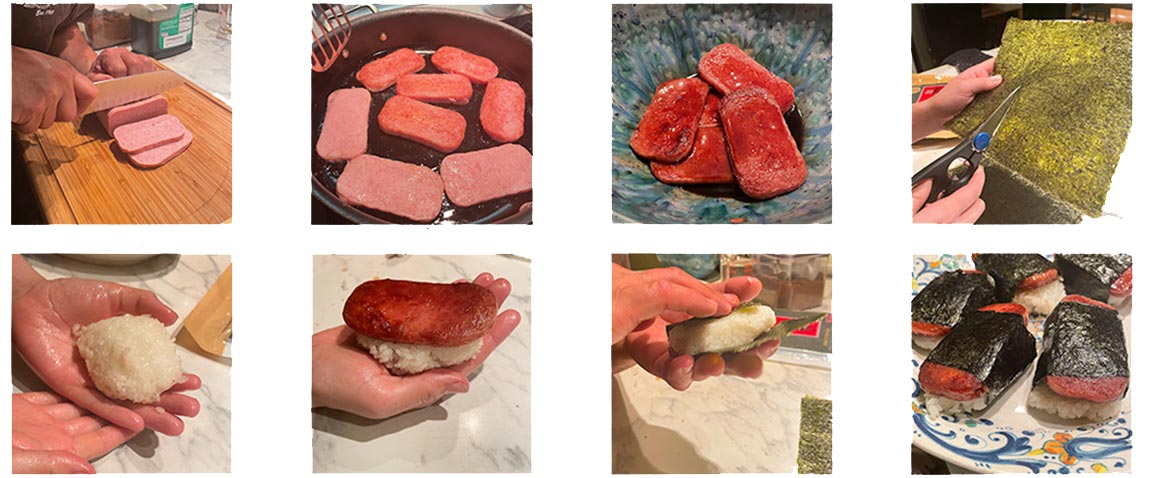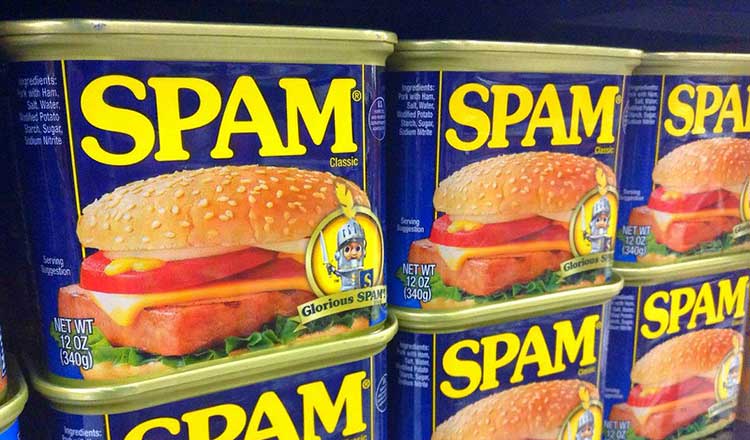Early in the semester, CIA students in my Food Writing course read “On Chicken Tenders,” by Helen Rosner, published in 2015 in Guernica. In this amusing but sincere defense of a derided, children’s menu staple, Rosner effectively argues against those who look down on ordering, eating, and celebrating the “perfect” (Rosner’s consistent and repeated descriptor) chicken tender.
In the course’s related writing prompts, students can choose to develop their own defense of an oft-maligned food. Over the years, students have written pieces defending the deliciousness of pizza rolls, deviled eggs, canned soup, Velveeta cheese, and, once, drowning nearly every food imaginable in shocking amounts of ketchup.
My choice, though, would be to defend Spam, that ridiculed, canned meat, too often referred to—incorrectly—as mystery meat. Although I caution students to avoid writing about specific brands, occasionally there is no way around it (hence the student who defended Velveeta), and Spam is in this rare category.
There is nothing like Spam.
No substitute will come close to delivering the same flavor profile and mouthfeel as that blue-canned original. It is a robust meat that adds salty richness to many dishes, while also being inexpensive and shelf stable. It should be a cherished pantry staple for anyone who consumes pork.
Spam’s ingredients are not a mystery: pork with ham, salt, water, modified potato starch, sugar, sodium nitrate. Admittedly, I pause over the description of pork with ham. (Isn’t all ham pork?) But, that fleeting question aside, Spam is good, wholesome food. It contains only six ingredients—all easy to pronounce and recognize—which is much better than many grocery store items people gobble with abandon.
On the first day of my Food in Film class, we watch Spam-Ku. It is a short, four-minute film, written and directed by Steven K. Tsuchida in 2004, which you can find online if you are interested in watching it yourself. The film’s central premise revolves around an isolated and quirky protagonist who writes a haiku for a contest and wins a prize of a lifetime of Spam. It’s an effective film that promotes a lot of discussion, and it works because—beyond the skill and talent of Tsuchida—most people in mainstream U.S. cultural have a negative view of Spam. Sometime after all the soldiers came home from World War II sick and tired of eating Spam as part of their military rations, we decided as a country that Spam was unquestionably awful and just plain weird.
Thankfully this condescension toward Spam never made it to Hawaii. My mother-in-law, whose father emigrated from Okinawa as a young child, grew up on the island of Oahu in Hawaii before moving to California after her high school graduation. I grew up in a small town in upstate New York. My family rarely went to restaurants. On the few celebratory occasions that we did go out to eat, the restaurants my parents chose were American-style bars and grills where steak, potatoes, seafood, and burgers reigned. When I first traveled to Hawaii to meet my husband’s extended family, I was amazed by the food—much of it new to me. I tried savory poi my first afternoon in Oahu and had sweet poi pancakes for breakfast the next morning. Later, I ordered shave ice with azuki beans as I walked along the beach. One evening, I ate the freshest poke I’d ever had in my life, followed with haupia for dessert.
And, one morning, as we set out for a hike, I was introduced to Spam musubi.
When you drop by a convenience store in Hawaii to grab some food to go, the hotdogs and pretzels, and slices of pizza that fill the shelves in convenience stores on the mainland are largely missing. Instead, there are poi donuts, crack seeds, sushi hand rolls—just to name a few of the many options—and rows and rows of Spam musubi.
Spam musubi makes for a quick, portable lunch on the go that is filling, rich and delicious. In its most basic form, it is a slice of seared Spam on a compact bed of sticky rice, wrapped in a strip of nori. You can sometimes find the basic recipe on the side of a can of Spam, and it is always available on the Spam website.
I remember stopping by a 7-11 one morning on our way to Lulumahu Falls. My husband’s cousin Blake picked out a Spam musubi for each of us, and we set out on our day’s adventure. When we arrived at the trailhead, we followed the path as it snaked upward through lush bamboo forest until we reached the falls. Spam musubi was soon handed out and quickly unwrapped. I was surprised by the interplay of flavors when I took the first bite. The umami of the caramelized Spam was complemented by the rice’s sweetness, creating a complexity of tastes and textures with each bite. We sat by the waterfall, eating Spam musubi and watching children dip their feet into the cold, churning water. It was a delicious and substantial lunch that left us satisfied but not uncomfortably full. When the time came to leave, we felt refreshed and ready to tackle the descent on the winding trail’s steep slopes through the forest.
Of course, you don’t have to be in Hawaii to enjoy Spam musubi. In our family, our kids have long asked that it be on menus for birthdays, New Year’s Eve, and other celebratory meals. It has also become one of my husband’s go-to dishes to serve at gatherings, as he attempts to entice the uninitiated. Usually, as the plate of Spam musubi is set among other dishes, it is met with surprise by those who don’t know us well enough to have seen all this before. Those who have seen this scenario play out at previous parties join in our defense of Spam, telling the skeptics they must try it.
And then people taste it for the first time, and their doubt transforms into surprised delight. They can’t believe Spam (Spam!) can be so damn good.
Spam musubi is easy and fun to make, as well. It takes about 30 minutes, start to finish and is one of the few recipes that virtually guarantees that our children, without even being asked, will appear in the kitchen, eager to help with the musubi construction.
I’m telling you, give Spam a chance. It’s full of surprises.
Ready to try Spam Musubi for yourself? Follow CIA professor Anne Henry’s family recipe!
Spam Musubi
Makes 8 pieces
Spam musubi is easy and fun to make, as well. It takes about 30 minutes, start to finish and is one of the few recipes that virtually guarantees that our children, without even being asked, will appear in the kitchen, eager to help with the musubi construction.
Ingredients
Directions

 Anne Henry is an associate professor at The Culinary Institute of America where she teaches Food Literature, Food Writing, and Food in Film as a part of the CIA’s Applied Food Studies bachelor’s degree program. She received her Bachelor of Arts (1993) and Master of Arts (1997) from the State University of New York (SUNY) at New Paltz, and taught freshman composition courses at SUNY New Paltz while pursuing her master’s degree. After graduation, she worked at The United States Chess Federation, in New Windsor, NY, as a copy editor and writer, and later became the Director of Marketing, Advertising, and Outreach. She joined the CIA liberal arts faculty in 2001.
Anne Henry is an associate professor at The Culinary Institute of America where she teaches Food Literature, Food Writing, and Food in Film as a part of the CIA’s Applied Food Studies bachelor’s degree program. She received her Bachelor of Arts (1993) and Master of Arts (1997) from the State University of New York (SUNY) at New Paltz, and taught freshman composition courses at SUNY New Paltz while pursuing her master’s degree. After graduation, she worked at The United States Chess Federation, in New Windsor, NY, as a copy editor and writer, and later became the Director of Marketing, Advertising, and Outreach. She joined the CIA liberal arts faculty in 2001.
Cover photo via Flickr // Mike Mozart // License


